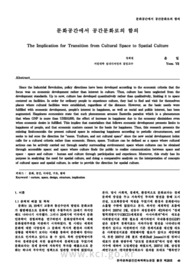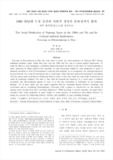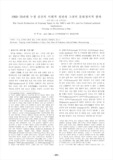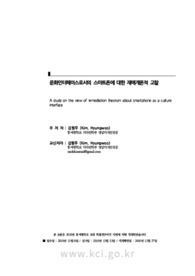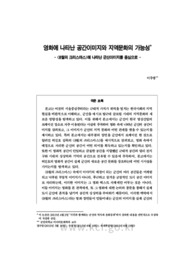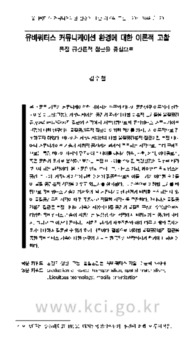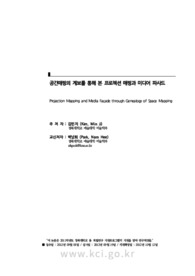

-
미리보기
서지정보
· 발행기관 : 한국문화공간건축학회
· 수록지 정보 : 한국문화공간건축학회논문집 / 28호 / 49 ~ 58페이지
· 저자명 : 윤일
초록
Since the Industrial Revolution, policy directions have been developed according to the economic criteria that the focus was on economic development rather than interest in culture. Thus, culture has been neglected from the development standards. Up to now, culture has developed quantitatively rather than qualitatively, limiting it to space centered on facilities. In order for ordinary people to experience culture, they had to find and visit for themselves places where cultural facilities were established, regardless of the distance. However, as the basic needs were fulfilled with economic development, people’s interest in happiness, as well as social and politic interest, has been augmented. Happiness economists state that such phenomenon arouses Easterlin paradox which is a phenomenon that when GNP is more than US$10,000, the effect of increase in happiness due to the economy diminishes even when economic desire is fulfilled. This implies that materialism that follows economic development presents limits to happiness of people, and that economic matters cannot be the basis for happiness. Thus, this research presents the existing limitconomiin the present cultural space in enhancing happiness according to periodic circumstances, and seeks to ind ecoe the direction for “sness. Tculture, and not cultural space” since the new social development index calls for a cultural criteria rather than economic. Hence, spass. Tculture can be defined as a space where cultural actions can be actively carried out through nearby surrounding environment; space where cultures can be obtained through accessible space; and space where culture finds the public to realize communication between space and space · space and culture · human and culture through participation and experience. Moreover, this study has its purpose in analyzing the need for spatial culture, and doing a comparative analysis on the interpretation of concepts of cultural space and spatial culture, in order to provide the direction for spatial culture.영어초록
Since the Industrial Revolution, policy directions have been developed according to the economic criteria that the focus was on economic development rather than interest in culture. Thus, culture has been neglected from the development standards. Up to now, culture has developed quantitatively rather than qualitatively, limiting it to space centered on facilities. In order for ordinary people to experience culture, they had to find and visit for themselves places where cultural facilities were established, regardless of the distance. However, as the basic needs were fulfilled with economic development, people’s interest in happiness, as well as social and politic interest, has been augmented. Happiness economists state that such phenomenon arouses Easterlin paradox which is a phenomenon that when GNP is more than US$10,000, the effect of increase in happiness due to the economy diminishes even when economic desire is fulfilled. This implies that materialism that follows economic development presents limits to happiness of people, and that economic matters cannot be the basis for happiness. Thus, this research presents the existing limitconomiin the present cultural space in enhancing happiness according to periodic circumstances, and seeks to ind ecoe the direction for “sness. Tculture, and not cultural space” since the new social development index calls for a cultural criteria rather than economic. Hence, spass. Tculture can be defined as a space where cultural actions can be actively carried out through nearby surrounding environment; space where cultures can be obtained through accessible space; and space where culture finds the public to realize communication between space and space · space and culture · human and culture through participation and experience. Moreover, this study has its purpose in analyzing the need for spatial culture, and doing a comparative analysis on the interpretation of concepts of cultural space and spatial culture, in order to provide the direction for spatial culture.참고자료
· 없음태그
-
자주묻는질문의 답변을 확인해 주세요

꼭 알아주세요
-
자료의 정보 및 내용의 진실성에 대하여 해피캠퍼스는 보증하지 않으며, 해당 정보 및 게시물 저작권과 기타 법적 책임은 자료 등록자에게 있습니다.
자료 및 게시물 내용의 불법적 이용, 무단 전재∙배포는 금지되어 있습니다.
저작권침해, 명예훼손 등 분쟁 요소 발견 시 고객센터의 저작권침해 신고센터를 이용해 주시기 바랍니다. -
해피캠퍼스는 구매자와 판매자 모두가 만족하는 서비스가 되도록 노력하고 있으며, 아래의 4가지 자료환불 조건을 꼭 확인해주시기 바랍니다.
파일오류 중복자료 저작권 없음 설명과 실제 내용 불일치 파일의 다운로드가 제대로 되지 않거나 파일형식에 맞는 프로그램으로 정상 작동하지 않는 경우 다른 자료와 70% 이상 내용이 일치하는 경우 (중복임을 확인할 수 있는 근거 필요함) 인터넷의 다른 사이트, 연구기관, 학교, 서적 등의 자료를 도용한 경우 자료의 설명과 실제 자료의 내용이 일치하지 않는 경우
“한국문화공간건축학회논문집”의 다른 논문도 확인해 보세요!
-
공동주택단지 내 어린이놀이터 이용 빈도에 영향을 미치는 물리적 환경요인에 관한 연구 - 동탄 신도시 내 아파트단지를 중심으로 .. 11 페이지
The purpose of this study is to investigate the frequency in the use of children’s playground, to determine the most preferable playground and analyze the environmental factors which effect the childr.. -
地域社會 公演場 活性化에 관한 分類分析 硏究 8 페이지
The aim of this study is to review various studies on raising the usefulness of culture and arts centers, which are community theater buildings, to discuss and analyze ways for revitalization of commu.. -
박물관 유형별 전시특성과 안내체계 디자인 방법 연구 8 페이지
To achieve the purpose of a museum, it is important to explore and design an information system method that is appropriate for the exhibition characteristics of each museum type. Based on this premise.. -
피터아이젠만의 주택작품에 나타난 데 스틸 적 특성에 관한 연구 8 페이지
There were various attempts to break exsiting frame in the beginning of modern architecture. Like Art-nouveau architecture, there was a case that an architect's inspiration became designed motivation ..
찾으시던 자료가 아닌가요?
지금 보는 자료와 연관되어 있어요!
문서 초안을 생성해주는 EasyAI
